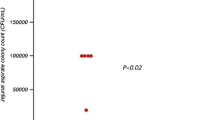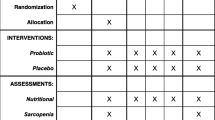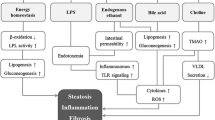Abstract
Background
Experimental and clinical studies suggest an association between small intestinal bacterial overgrowth (SIBO) and nonalcoholic steatohepatitis (NASH). Liver injury and fibrosis could be related to exposure to bacterial products of intestinal origin and, most notably, endotoxin, including lipopolysaccharide (LPS).
Aim
To compare the prevalence of SIBO and its relationships to LPS receptor levels and systemic cytokines in NASH patients and healthy control subjects.
Methods
Eighteen NASH patients (eight males) and 16 age-matched and gender-matched healthy volunteers were studied. SIBO was assessed by the lactulose breath hydrogen test (LHBT), plasma lipopolysaccharide binding protein (LBP) levels by ELISA, and expression (as a percentage) of TLR-2 and 4 on CD14-positive cells by flow cytometry. Pro-inflammatory cytokines (IL-1β, IL-6, IL-8, and TNF-α) were measured in plasma.
Results
SIBO was more common in NASH patients than control subjects (77.78% vs. 31.25%; P < 0.0001). LBP levels and TLR-2 expression were similar in both groups, TLR-4/MD-2 expression on CD14 positive cells was higher among NASH patients: expression, mean ± SEM, NASH vs. control: 20.95 ± 2.91% vs. 12.73 ± 2.29%, P < 0.05. Among the examined cytokines, only IL-8 levels were significantly higher in patients than control (P = 0.04) and correlated positively with TLR-4 expression (r = 0.5123, P = 0.036).
Conclusion
NASH patients have a higher prevalence of small intestinal bacterial overgrowth which is associated with enhanced expression of TLR-4 and release of IL-8. SIBO may have an important role in NASH through interactions with TLR-4 and induction of the pro-inflammatory cytokine, IL-8.





Similar content being viewed by others
References
Matteoni CA, Younossi ZM, Gramlich T, et al. Nonalcoholic fatty liver disease: A spectrum of clinical and pathological severity. Gastroenterology. 1999;116:1413–1419.
Kleiner DE, Brunt EM, Van Natta M, et al. Design and validation of a histological scoring system for nonalcoholic fatty liver disease. Hepatology. 2005;41:1313–1321.
Maeda T, Hashimoto K, Kihara Y, et al. Surgically resected hepatocellular carcinomas in patients with non-alcoholic steatohepatitis. Hepatogastroenterology. 2008;55:1404–1406.
Day CP, James O. Steatohepatitis: A tale of two “hits”? Gastroenterology. 1998;114:842–845.
Day CP. Non-alcoholic steatohepatitis (NASH): Where are we now and where are we going? Gut. 2002;50:585–588.
Namikawa C, Zhang H, Toi M. Non-alcoholic steatohepatitis: Pathology and pathogenesis. Nippon Rinsho. 2006;64:1107–1113.
Nazim M, Stamp G, Hodgson HJ. Non-alcoholic steatohepatitis associated with small intestinal diverticulosis and bacterial overgrowth. Hepatogastroenterology. 1989;36:349–351.
Zhao LF, Jia JM, Han DW. The role of enterogenous endotoxemia in the pathogenesis of non-alcoholic steatohepatitis. Zhonghua Gan Zang Bing Za Zhi. 2004;12:632.
Fu JF, Fang YL, Liang L, et al. A rabbit model of pediatric nonalcoholic steatohepatitis: The role of adiponectin. World J Gastroenterol. 2009;15:912–918.
Soza A, Riquelme A, Gonzalez R, et al. Increased orocecal transit time in patients with nonalcoholic fatty liver disease. Dig Dis Sci. 2005;50:1136–1140.
Fan JG, Xu ZJ, Wang GL. Effect of lactulose on establishment of a rat non-alcoholic steatohepatitis model. World J Gastroenterol. 2005;11:5053–5056.
Wigg AJ, Roberts-Thomson IC, Dymock RB, et al. The role of small intestinal bacterial overgrowth, intestinal permeability, endotoxaemia, and tumour necrosis factor alpha in the pathogenesis of non-alcoholic steatohepatitis. Gut. 2001;48:206–211.
Riordan SM, McIver CJ, Williams R. Liver damage in human small intestinal bacterial overgrowth. Am J Gastroenterol. 1998;93:234–237.
Wu WC, Zhao W, Li S. Small intestinal bacteria overgrowth decreases small intestinal motility in the NASH rats. World J Gastroenterol. 2008;14:313–317.
Cuoco L, Montalto M, Jorizzo RA, et al. Eradication of small intestinal bacterial overgrowth and oro-cecal transit in diabetics. Hepatogastroenterology. 2002;49:1582–1586.
Basilisco G, Camboni G, Bozzani A, et al. Orocecal transit delay in obese patients. Dig Dis Sci. 1989;34:509–512.
Sabate JM, Jouet P, Harnois F, et al. High prevalence of small intestinal bacterial overgrowth in patients with morbid obesity: A contributor to severe hepatic steatosis. Obes Surg. 2008;18:371–377.
Pilotto A, Franceschi M, Del Favero G, et al. The effect of aging on oro-cecal transit time in normal subjects and patients with gallstone disease. Aging (Milano). 1995;7:234–237.
Elphick DA, Chew TS, Higham SE, et al. Small bowel bacterial overgrowth in symptomatic older people: Can it be diagnosed earlier? Gerontology. 2005;51:396–401.
Madrid AM, Cumsille F, Defilippi C. Altered small bowel motility in patients with liver cirrhosis depends on severity of liver disease. Dig Dis Sci. 1997;42:738–742.
Chesta J, Defilippi C, Defilippi C. Abnormalities in proximal small bowel motility in patients with cirrhosis. Hepatology. 1993;17:828–832.
Gunnarsdottir SA, Sadik R, Shev S, et al. Small intestinal motility disturbances and bacterial overgrowth in patients with liver cirrhosis and portal hypertension. Am J Gastroenterol. 2003;98:1362–1370.
Chang CS, Chen GH, Lien HC, et al. Small intestine dysmotility and bacterial overgrowth in cirrhotic patients with spontaneous bacterial peritonitis. Hepatology. 1998;28:1187–1190.
Pardo A, Bartoli R, Lorenzo-Zuniga V, et al. Effect of cisapride on intestinal bacterial overgrowth and bacterial translocation in cirrhosis. Hepatology. 2000;31:858–863.
Gao Y, Song LX, Jiang MN, et al. Effects of traditional Chinese medicine on endotoxin and its receptors in rats with non-alcoholic steatohepatitis. Inflammation. 2008;31:121–132.
Dumas ME, Barton RH, Toye A, et al. Metabolic profiling reveals a contribution of gut microbiota to fatty liver phenotype in insulin-resistant mice. Proc Natl Acad Sci U S A. 2006;103:12511–12516.
Cani PD, Amar J, Iglesias MA, et al. Metabolic endotoxemia initiates obesity and insulin resistance. Diabetes. 2007;56:1761–1772.
Yang SQ, Lin HZ, Lane MD, et al. Obesity increases sensitivity to endotoxin liver injury: Implications for the pathogenesis of steatohepatitis. Proc Natl Acad Sci U S A. 1997;94:2557–2562.
Drewe J, Beglinger C, Fricker G. Effect of ischemia on intestinal permeability of lipopolysaccharides. Eur J Clin Invest. 2001;31:138–144.
Neal MD, Leaphart C, Levy R, et al. Enterocyte TLR4 mediates phagocytosis and translocation of bacteria across the intestinal barrier. J Immunol. 2006;176:3070–3079.
Moore FA, Moore EE, Poggetti R, et al. Gut bacterial translocation via the portal vein: A clinical perspective with major torso trauma. J Trauma. 1991;31:629–636.
Tomita M, Ohkubo R, Hayashi M. Lipopolysaccharide transport system across colonic epithelial cells in normal and infective rat. Drug Metab Pharmacokinet. 2004;19:33–40.
Wright SD, Ramos RA, Tobias PS, et al. CD14, a receptor for complexes of lipopolysaccharide (LPS) and LPS binding protein. Science. 1990;249:1431–1433.
Vreugdenhil AC, Rousseau CH, Hartung T, et al. Lipopolysaccharide (LPS)-binding protein mediates LPS detoxification by chylomicrons. J Immunol. 2003;170:1399–1405.
Wu RQ, Xu YX, Song XH, et al. Adhesion molecule and proinflammatory cytokine gene expression in hepatic sinusoidal endothelial cells following cecal ligation and puncture. World J Gastroenterol. 2001;7:128–130.
Gutsmann T, Muller M, Carroll SF, et al. Dual role of lipopolysaccharide (LPS)-binding protein in neutralization of LPS and enhancement of LPS-induced activation of mononuclear cells. Infect Immun. 2001;69:6942–6950.
Heumann D, Adachi Y, Le Roy D, et al. Role of plasma, lipopolysaccharide-binding protein, and CD14 in response of mouse peritoneal exudate macrophages to endotoxin. Infect Immun. 2001;69:378–385.
Tobias PS, Soldau K, Gegner JA, et al. Lipopolysaccharide binding protein-mediated complexation of lipopolysaccharide with soluble CD14. J Biol Chem. 1995;270:10482–10488.
Romics L Jr, Mandrekar P, Kodys K, Velayudham A, Drechsler Y, Dolganiuc A, Szabo G. Increased lipopolysaccharide sensitivity in alcoholic fatty livers is independent of leptin deficiency and toll-like receptor 4 (TLR4) or TLR2 mRNA expression. Alcohol Clin Exp Res. 2005;9:1018–1026.
Medvedev AE, Vogel SN. Overexpression of CD14, TLR4, and MD-2 in HEK 293T cells does not prevent induction of in vitro endotoxin tolerance. J Endotoxin Res. 2003;9:60–64.
Nagai Y, Akashi S, Nagafuku M, et al. Essential role of MD-2 in LPS responsiveness and TLR4 distribution. Nat Immunol. 2002;3:667–672.
Tazi KA, Quioc JJ, Saada V, et al. Upregulation of TNF-alpha production signaling pathways in monocytes from patients with advanced cirrhosis: Possible role of Akt and IRAK-M. J Hepatol. 2006;45:280–289.
Paik YH, Schwabe RF, Bataller R, et al. Toll-like receptor 4 mediates inflammatory signaling by bacterial lipopolysaccharide in human hepatic stellate cells. Hepatology. 2003;37:1043–1055.
Thurman RG, Bradford BU, Knecht KT, et al. Endotoxin, Kupffer cells and alcoholic liver injury. In: Blum HE, Bode Ch, Bode JCh, Sartor RB (ed) Gut and the liver. Falk Symposium 100, Dordrecht, The Netherlands. Kluwer Academic Publishers Group, 1997:222–240.
Bode Ch, Schafer C, Bode JCh. The role of gut derived bacterial toxins (endotoxin) for the development of alcoholic liver disease in man. In: Blum HE, Bode Ch, Bode JCh, Sartor RB (ed) Gut and the liver. Falk Symposium 100, Dordrecht, The Netherlands. Kluwer Academic Publishers Group, 1997:281–298.
McClain CJ, Song Z, Barve SS, et al. Recent advances in alcoholic liver disease. IV. Dysregulated cytokine metabolism in alcoholic liver disease. Am J Physiol Gastrointest Liver Physiol. 2004;287:G497–G502.
Copaci I, Micu L, Voiculescu M. The role of cytokines in non-alcoholic steatohepatitis. A review. J Gastrointest Liver Dis. 2006;15:363–373.
Hui JM, Hodge A, Farrell GC, et al. Beyond insulin resistance in NASH: TNF-alpha or adiponectin? Hepatology. 2004;40:46–54.
Kugelmas M, Hill DB, Vivian B, et al. Cytokines and NASH: A pilot study of the effects of lifestyle modification and vitamin E. Hepatology. 2003;38:413–419.
Crespo J, Cayon A, Fernandez-Gil P, et al. Gene expression of tumor necrosis factor alpha and TNF-receptors, p55 and p75, in nonalcoholic steatohepatitis patients. Hepatology. 2001;34:1158–1163.
Feldstein AE, Werneburg NW, Canbay A, et al. Free fatty acids promote hepatic lipotoxicity by stimulating TNF-alpha expression via a lysosomal pathway. Hepatology. 2004;40:185–194.
Jung BD, Kimura K, Kitamura H, et al. Norepinephrine stimulates interleukin-6 mRNA expression in primary cultured rat hepatocytes. J Biochem. 2000;127:205–209.
Tilg H, Diehl AM. Cytokines in alcoholic and nonalcoholic steatohepatitis. N Engl J Med. 2000;343:1467–1476.
West DA, James NH, Cosulich SC, et al. Role for tumor necrosis factor a receptor 1 and interleukin-1 receptor in the suppression of mouse hepatocyte apoptosis by the peroxisome proliferator nafenopin. Hepatology. 1999;30:1417–1424.
Browning JD, Horton JD. Molecular mediators of hepatic steatosis and liver injury. J Clin Invest. 2004;114:147–152.
Nonalcoholic steatohepatitis clinical research network. Hepatology. 2003;37:244.
Kerlin P, Wong L. Breath hydrogen testing in bacterial overgrowth of the small intestine. Gastroenterology. 1988;95:982–988.
Corazza GR, Strocchi A, Gasbarrini G. Fasting breath hydrogen in celiac disease. Gastroenterology. 1987;93:53–58.
Perman JA, Modler S, Barr RG, et al. Fasting breath hydrogen concentration: Normal values and clinical application. Gastroenterology. 1984;87:1358–1363.
Sharara AI, Aoun E, Abdul-Baki H, et al. A randomized double-blind placebo-controlled trial of rifaximin in patients with abdominal bloating and flatulence. Am J Gastroenterol. 2006;101:326–333.
Posserud I, Stotzer PO, Bjornsson ES, et al. Small intestinal bacterial overgrowth in patients with irritable bowel syndrome. Gut. 2007;56:802–808.
Pimentel M, Chow EJ, Lin HC. Normalization of lactulose breath testing correlates with symptom improvement in irritable bowel syndrome. A double-blind, randomized, placebo-controlled study. Am J Gastroenterol. 2003;98:412–419.
Walters B, Vanner SJ. Detection of bacterial overgrowth in IBS using the lactulose H2 breath test: Comparison with 14C-D-xylose and healthy controls. Am J Gastroenterol. 2005;100:1566–1570.
Bratten JR, Spanier J, Jones MP. Lactulose hydrogen breath testing (LHBT) in patients with IBS and controls: Differences in methane (CH4) but not hydrogen (H2). Am J Gastroenterol. 2006;101:S479.
Simon D, Borelli S, Braathen LR, Simon HU. Peripheral blood mononuclear cells from IgE- and non-IgE-associated allergic atopic eczema/dermatitis syndrome (AEDS) demonstrate increased capacity of generating interleukin-13 but differ in their potential of synthesizing interferon-gamma. Allergy. 2002;57:431–435.
Bihl T, Vassina E, Boettger MK, et al. The T348M mutated form of cryopyrin is associated with defective lipopolysaccharide-induced interleukin 10 production in CINCA syndrome. Ann Rheum Dis. 2005;64:1380–1381.
de Oliveira CP, Stefano JT, de Siqueira ER, et al. Combination of N-acetylcysteine and metformin improves histological steatosis and fibrosis in patients with non-alcoholic steatohepatitis. Hepatol Res. 2008;38:159–165.
Gisbert JP, Gonzalez-Lama Y. Breath tests in the diagnosis of gastrointestinal diseases. Gastroenterol Hepatol. 2005;28:407–416.
Kristensen M, Hoeck HC. Abnormal flora in the small intestine. Diagnostic evaluation of the H2 breath test. Ugeskr Laeger. 1994;156:7530–7533.
Romagnuolo J, Schiller D, Bailey RJ. Using breath tests wisely in a gastroenterology practice: An evidence-based review of indications and pitfalls in interpretation. Am J Gastroenterol. 2002;97:1113–1126.
Bauer TM, Schwacha H, Steinbruckner B, et al. Diagnosis of small intestinal bacterial overgrowth in patients with cirrhosis of the liver: Poor performance of the glucose breath hydrogen test. J Hepatol. 2000;33:382–386.
Farrell G. Is bacterial ash the flash that ignites NASH? Gut. 2001;48:148–149.
Sajjad A, Mottershead M, Syn WK, et al. Ciprofloxacin suppresses bacterial overgrowth, increases fasting insulin but does not correct low acylated ghrelin concentration in non-alcoholic steatohepatitis. Aliment Pharmacol Ther. 2005;22:291–299.
Reilly JA Jr, Quigley EM, Forst CF, et al. Small intestinal transit in the portal hypertensive rat. Gastroenterology. 1991;100:670–674.
Casafont Morencos F, de las Heras Castano G, Martin Ramos L, et al. Small bowel bacterial overgrowth in patients with alcoholic cirrhosis. Dig Dis Sci. 1996;41:552–556.
Prytz H, Holst-Christensen J, Korner B, et al. Portal venous and systemic endotoxaemia in patients without liver disease and systemic endotoxaemia in patients with cirrhosis. Scand J Gastroenterol. 1976;11:857–863.
Lumsden AB, Henderson JM, Kutner MH. Endotoxin levels measured by a chromogenic assay in portal, hepatic and peripheral venous blood in patients with cirrhosis. Hepatology. 1988;8:232–236.
Hurley JC, Tosolini FA, Louis WJ. Quantitative limulus lysate assay for endotoxin and the effect of plasma. J Clin Pathol. 1991;44:849–854.
Jin X, Yu CH, Lv GC, et al. Increased intestinal permeability in pathogenesis and progress of nonalcoholic steatohepatitis in rats. World J Gastroenterol. 2007;13:1732–1736.
Tarao K, So K, Moroi T, et al. Detection of endotoxin in plasma and ascitic fluid of patients with cirrhosis: Its clinical significance. Gastroenterology. 1977;73:539–542.
Ruiz AG, Casafont F, Crespo J, et al. Lipopolysaccharide-binding protein plasma levels and liver TNF-alpha gene expression in obese patients: Evidence for the potential role of endotoxin in the pathogenesis of non-alcoholic steatohepatitis. Obes Surg. 2007;17:1374–1380.
Kopp E, Medzhitov R. Recognition of microbial infection by toll-like receptors. Curr Opin Immunol. 2003;15:396–401.
Igolnikov AC, Green RM. C3H/HEJ mice with mutations of the toll-like receptor 4 (TLR-4) are resistant to the methionine-choline deficient (MCD) diet induced non-alcoholic steatohepatitis (NASH). Hepatology. 2003;36:A404.
Rivera CA, Adegboyega P, van Rooijen N, et al. Toll-like receptor-4 signaling and kupffer cells play pivotal roles in the pathogenesis of non-alcoholic steatohepatitis. J Hepatol. 2007;47:571–579.
Stadlbauer V, Mookerjee RP, Hodges S, et al. Effect of probiotic treatment on deranged neutrophil function and cytokine responses in patients with compensated alcoholic cirrhosis. J Hepatol. 2008;48:945–951.
Szabo G, Velayudham A, Romics L Jr, et al. Modulation of non-alcoholic steatohepatitis by pattern recognition receptors in mice: The role of toll-like receptors 2 and 4. Alcohol Clin Exp Res. 2005;29(11 Suppl):140S–145S.
Tuncer I, Özbek H, Topal H, Uygan I. The serum levels of IL-1B, Il-6, IL-8 and TNF alpha in non alcoholic fatty liver disease. Turk J Med Sci. 2003;33:381–386.
Bahcecioglu IH, Yalniz M, Ataseven H, et al. Levels of serum hyaluronic acid, TNF-alpha and IL-8 in patients with nonalcoholic steatohepatitis. Hepatogastroenterology. 2005;52:1549–1553.
Torer N, Ozenirler S, Yucel A, et al. Importance of cytokines, oxidative stress and expression of BCL-2 in the pathogenesis of non-alcoholic steatohepatitis. Scand J Gastroenterol. 2007;42:1095–1101.
Jarrar MH, Baranova A, Collantes R, et al. Adipokines and cytokines in non-alcoholic fatty liver disease. Aliment Pharmacol Ther. 2008;27:412–421.
Yin M, Wheeler MD, Kono H, et al. Essential role of tumor necrosis factor alpha in alcohol-induced liver injury in mice. Gastroenterology. 1999;117:942–952.
McClain C, Hill D, Schmidt J, et al. Cytokines and alcoholic liver disease. Semin Liver Dis. 1993;13:170–182.
Wolff B, Burns AR, Middleton J, et al. Endothelial cell “memory” of inflammatory stimulation: Human venular endothelial cells store interleukin 8 in Weibel-Palade bodies. J Exp Med. 1998;188:1757–1762.
Mohler KM, Sleath PR, Fitzner JN, et al. Protection against a lethal dose of endotoxin by an inhibitor of tumour necrosis factor processing. Nature. 1994;370:218–220.
Ashkenazi A, Marsters SA, Capon DJ, et al. Protection against endotoxic shock by a tumor necrosis factor receptor immunoadhesin. Proc Natl Acad Sci USA. 1991;88:10535–10539.
Zhang H, Feng Q, Li HS, et al. Effects of Qushi Huayu Decoction on cathepsin B and tumor necrosis factor-alpha expression in rats with non-alcoholic steatohepatitis. Zhong Xi Yi Jie He Xue Bao. 2008;6:928–933.
Diehl AM. Tumor necrosis factor and its potential role in insulin resistance and nonalcoholic fatty liver disease. Clin Liver Dis. 2004;8:619–638.
Lesmana CR, Lesmana LA, Akbar N, et al. Clinical picture, insulin resistance, and adipocytokines profiles of nonalcoholic steatohepatitis (NASH) patients in Indonesia. Acta Med Indones. 2009;41:6–10.
Schramm C, Schneider A, Marx A, Lohse AW. Adalimumab could suppress the activity of non alcoholic steatohepatitis (NASH). Z Gastroenterol. 2008;46:1369–1371.
Tomita K, Tamiya G, Ando S, et al. Tumour necrosis factor alpha signalling through activation of Kupffer cells plays an essential role in liver fibrosis of non-alcoholic steatohepatitis in mice. Gut. 2006;55:415–424.
Roilides E, Katsifa H, Tsaparidou S, et al. Interleukin 10 suppresses phagocytic and antihyphal activities of human neutrolphils. Cytokine. 2000;12:379–387.
Laichalk LL, Danforth JM, Standiford TJ. Interleukin-10 inhibits neutrophil phagocytic and bactericidal activity. FEMS Immunol Med Microbiol. 1996;15:181–187.
Poniachik J, Csendes A, Diaz JC, et al. Increased production of IL-1alpha and TNF-alpha in lipopolysaccharide-stimulated blood from obese patients with non-alcoholic fatty liver disease. Cytokine. 2006;33:252–257.
De Groote D, Zangerle PF, Gevaert Y, et al. Direct stimulation of cytokines (IL-1 beta, TNF-alpha, IL-6, IL-2, IFN-gamma and GM-CSF) in whole blood. I. Comparison with isolated PBMC stimulation. Cytokine. 1992;4:239–248.
Mayringer I, Reindl M, Berger T. A critical comparison of frequently used methods for the analysis of tumor necrosis factor-alpha expression by human immune cells. J Immunol Methods. 2000;235:33–40.
Acknowledgments
Supported in part by an award to the Alimentary Pharmabiotic Centre by Science Foundation Ireland and by a scholarship to AAS from the Egyptian Government.
Author information
Authors and Affiliations
Corresponding author
Rights and permissions
About this article
Cite this article
Shanab, A.A., Scully, P., Crosbie, O. et al. Small Intestinal Bacterial Overgrowth in Nonalcoholic Steatohepatitis: Association with Toll-Like Receptor 4 Expression and Plasma Levels of Interleukin 8. Dig Dis Sci 56, 1524–1534 (2011). https://doi.org/10.1007/s10620-010-1447-3
Received:
Accepted:
Published:
Issue Date:
DOI: https://doi.org/10.1007/s10620-010-1447-3




